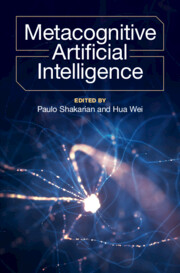Refine search
Actions for selected content:
48532 results in Computer Science
Hiord
 $^{{\kern2pt}\sharp}$: An Approach to the Specification and Verification of Higher-Order (C)LP Programs
$^{{\kern2pt}\sharp}$: An Approach to the Specification and Verification of Higher-Order (C)LP Programs
-
- Journal:
- Theory and Practice of Logic Programming / Volume 25 / Issue 4 / July 2025
- Published online by Cambridge University Press:
- 09 September 2025, pp. 612-630
-
- Article
-
- You have access
- Open access
- HTML
- Export citation
Enhancing designer creativity through human–AI co-ideation: a co-creation framework for design ideation with custom GPT
-
- Article
-
- You have access
- Open access
- HTML
- Export citation
On orderings of vectors of order statistics and sample ranges from heterogeneous bivariate Pareto variables
-
- Journal:
- Probability in the Engineering and Informational Sciences , First View
- Published online by Cambridge University Press:
- 09 September 2025, pp. 1-16
-
- Article
-
- You have access
- Open access
- HTML
- Export citation
Proper minor-closed classes of graphs have Assouad–Nagata dimension 2
- Part of
-
- Journal:
- Combinatorics, Probability and Computing , First View
- Published online by Cambridge University Press:
- 09 September 2025, pp. 1-25
-
- Article
-
- You have access
- Open access
- HTML
- Export citation
Discourse, hegemony, and the public sphere: A theoretical framework for the empirical modelling of memory
- Part of
-
- Journal:
- Memory, Mind & Media / Volume 4 / 2025
- Published online by Cambridge University Press:
- 09 September 2025, e13
-
- Article
-
- You have access
- Open access
- HTML
- Export citation

Metacognitive Artificial Intelligence
-
- Published online:
- 08 September 2025
- Print publication:
- 25 September 2025
Symbolic Rule Extraction From Attention-Guided Sparse Representations in Vision Transformers
-
- Journal:
- Theory and Practice of Logic Programming / Volume 25 / Issue 4 / July 2025
- Published online by Cambridge University Press:
- 08 September 2025, pp. 722-738
-
- Article
-
- You have access
- Open access
- HTML
- Export citation
Harnessing hybrid digital twinning for decision-support in smart infrastructures
-
- Journal:
- Data-Centric Engineering / Volume 6 / 2025
- Published online by Cambridge University Press:
- 08 September 2025, e43
-
- Article
-
- You have access
- Open access
- HTML
- Export citation
Automatically testing console I/O behavior of student submissions in Haskell
-
- Journal:
- Journal of Functional Programming / Volume 35 / 2025
- Published online by Cambridge University Press:
- 08 September 2025, e18
-
- Article
-
- You have access
- Open access
- HTML
- Export citation

1000 Platforms
- Ensembles as Ontological Experiments
-
- Published by:
- Bristol University Press
- Published online:
- 06 September 2025
- Print publication:
- 28 April 2025

Killing the Messenger
- The War on Social Media
-
- Published online:
- 05 September 2025
- Print publication:
- 25 September 2025
-
- Book
-
- You have access
- Open access
- Export citation
Introducing and applying varinaccuracy: a measure for doubly truncated random variables in reliability analysis
- Part of
-
- Journal:
- Probability in the Engineering and Informational Sciences , First View
- Published online by Cambridge University Press:
- 05 September 2025, pp. 1-27
-
- Article
-
- You have access
- Open access
- HTML
- Export citation
Complexity of Faceted Explanations in Propositional Abduction
-
- Journal:
- Theory and Practice of Logic Programming / Volume 25 / Issue 4 / July 2025
- Published online by Cambridge University Press:
- 05 September 2025, pp. 775-793
-
- Article
-
- You have access
- Open access
- HTML
- Export citation
ASP-FZN: A Translation-Based Constraint Answer Set Solver
-
- Journal:
- Theory and Practice of Logic Programming / Volume 25 / Issue 4 / July 2025
- Published online by Cambridge University Press:
- 05 September 2025, pp. 649-667
-
- Article
-
- You have access
- Open access
- HTML
- Export citation
Fine-Grained Timing Analysis of Digital Integrated Circuits in Answer Set Programming
-
- Journal:
- Theory and Practice of Logic Programming / Volume 25 / Issue 4 / July 2025
- Published online by Cambridge University Press:
- 05 September 2025, pp. 522-539
-
- Article
-
- You have access
- Open access
- HTML
- Export citation

Rethinking the Lawyers' Monopoly
- Access to Justice and the Future of Legal Services
-
- Published online:
- 04 September 2025
- Print publication:
- 18 September 2025
-
- Book
-
- You have access
- Open access
- Export citation
Spectral goodness-of-fit tests for complete and partial network data
-
- Journal:
- Network Science / Volume 13 / 2025
- Published online by Cambridge University Press:
- 04 September 2025, e11
-
- Article
-
- You have access
- Open access
- HTML
- Export citation
Setting-driven design: a context-driven approach to behavioural design
-
- Journal:
- Design Science / Volume 11 / 2025
- Published online by Cambridge University Press:
- 04 September 2025, e35
-
- Article
-
- You have access
- Open access
- HTML
- Export citation





 better classification accuracy than the standard ViT while enabling symbolic reasoning. Crucially, the extracted rule-set is not merely post-hoc but acts as a logic-based decision layer that operates directly on the sparse concept representations. The resulting programs are concise and semantically meaningful. This work is the first to extract executable logic programs from ViTs using sparse symbolic representations, providing a step forward in interpretable and verifiable neuro-symbolic AI.
better classification accuracy than the standard ViT while enabling symbolic reasoning. Crucially, the extracted rule-set is not merely post-hoc but acts as a logic-based decision layer that operates directly on the sparse concept representations. The resulting programs are concise and semantically meaningful. This work is the first to extract executable logic programs from ViTs using sparse symbolic representations, providing a step forward in interpretable and verifiable neuro-symbolic AI.